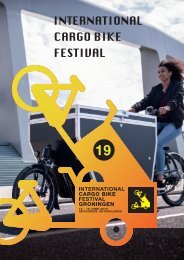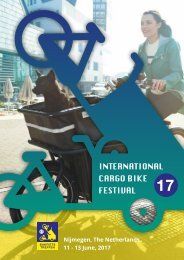International Cargo Bike Festival 2018
Create successful ePaper yourself
Turn your PDF publications into a flip-book with our unique Google optimized e-Paper software.
#ICBF<strong>2018</strong><br />
<strong>Cargo</strong> <strong>Bike</strong>s in Rotterdam<br />
By Tim Sjouke<br />
<strong>Cargo</strong> bikes in Rotterdam to make the urban distribution more sustainable; it is an inspiring<br />
vision of the future, yet it is one that is slowly turning into reality. The use of human-powered<br />
vehicles in urban distribution is increasing, but to what extent should we remodel the city<br />
to accommodate these newcomers? What infrastructural changes are necessary and what<br />
opportunities arise in the design of public spaces?<br />
The first step in improving the operability<br />
of cargo bikes is simply following the<br />
guidelines for the design of cycling<br />
infrastructure. The Dutch guidelines are<br />
managed by CROW; the Dutch technology<br />
platform for transport, infrastructure<br />
and public space. The Recommendations<br />
for traffic provisions in built-up areas 1 are<br />
also available in English and German.<br />
Additionally, an upgrade in the design of<br />
urban public spaces can also benefit a<br />
sustainable way urban distribution.<br />
It focuses primarily on reconfiguring the so-called urban traffic<br />
environments. This allows the problems in the infrastructure to<br />
be identified and addressed.<br />
In addition, local opportunities can be found through a spatial<br />
design framework. This framework, Functional Ambiance 3 , makes<br />
the connection between traffic and the public space itself.<br />
Flows and places come together within this framework. These<br />
frameworks aid the integration of the cargo bike into the urban<br />
traffic and show which local optimisations are possible. In <strong>Cargo</strong><br />
bikes in Rotterdam, seven streets in Rotterdam are analysed to<br />
explore the opportunities in practice.<br />
Two innovative design frameworks are used<br />
to examine the infrastructural complexities<br />
and to inspire a smarter design of the<br />
public domain.<br />
The traffic-based framework, Urban<br />
Mobility 2 , is a new approach to the design<br />
of urban public space.<br />
1. CROW. (1998). ASVV – Recommendations for traffic provisions in built-up areas. Ede, The Netherlands: CROW.<br />
2. Immers, Egeter, Diepens, & Weststrate. (2016). Urban Mobility. The Hague, The Netherlands: ANWB.<br />
3. Verheijen, & Smidt. (2013). Functional Ambiance. Rotterdam, The Netherlands: Research Centre Sustainable Solutions,<br />
Rotterdam University of Applied Sciences.<br />
4. Hoogendoorn, van Lonkhuizen, van der Ree & Sjouke. (<strong>2018</strong>). <strong>Cargo</strong> bikes in Rotterdam.<br />
Rotterdam, The Netherlands: University of Applied Sciences.<br />
7






